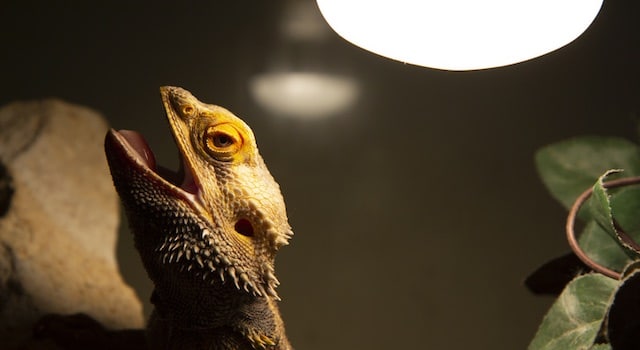
Introduction to Bearded Dragon Temperatures
Bearded dragon temperatures play an important role in the health and behavior of bearded dragons. It affects their digestion, metabolism, activity levels, and calcium absorption. They are ectothermic (cold-blooded) reptiles that rely on external heat to regulate their internal body temperature.
Without the correct temperatures, bearded dragons can become very sick and eventually die. That’s why, as a responsible owner, you must always maintain optimal bearded dragon temperatures to keep your pet healthy.
This article will tell you everything you need to know about bearded dragon temperatures and the best heating equipment to use.
Understanding Temperature Needs
Bearded dragons need a proper temperature gradient to thermoregulate and maintain an ideal body temperature. They thermoregulate by moving between different temperature zones in the enclosure to warm up and cool down.
The temperatures below are based on studies conducted by Dr. Jonathan Howard in their natural Australian outback environment.
- Basking surface temperature: 107-113°F (42-45°C)
- Cool side surface temperature: 77-84°F (25-29°C)
- Air temperature gradient: 72-99°F (22-37°C)
- Nighttime temperature: 50-75°F (10-24°C)
It’s important to never let the temperature drop below 50°F (10°C), which is the lowest temperature bearded dragons can tolerate for a short time without experiencing health and behavioral issues.
Basking Spot
Bearded dragons are native to hot, arid regions in Australia, where they regularly bask underneath the harsh sun for warmth. The heat from the sun warms up their bodies and aids in important functions like digestion, metabolism, and temperature regulation. Bearded dragons don’t have access to sunlight in captivity, so they need a basking spot in their enclosure to replicate these conditions. The basking spot should be the hottest part of the enclosure.
Cool Side
Bearded dragons need a cool section in the enclosure to cool down after basking. They can quickly overheat if they cannot cool down properly, which can be fatal. The cool side of the enclosure should ideally be opposite the basking spot and have a temperature range of 77-84°F (25-29°C).
Air Temperature Gradient
This refers to the ambient temperature in the enclosure and ensures that your bearded dragon can comfortably move around the enclosure without experiencing extreme changes in temperature. The ideal air temperature range for these reptiles is between 72-99°F (22-37°C), regardless of their age.
Nighttime Temperature
At night, the temperatures should gradually drop to 50-75°F (10-24°C) to replicate the temperature changes in their natural habitat. Bearded dragons are diurnal, meaning that they are active during the day and sleep at night when temperatures are cooler. They do not need much warmth while sleeping, and it’s normal for their body temperature to drop.
Heating Equipment for Optimal Bearded Dragon Temperatures
There are several types of heating equipment you can use to maintain an ideal temperature range in your bearded dragon’s enclosure.
Best types of heating equipment:
- Incandescent flood globes
- High-wattage halogen globes
- Ceramic heat emitters
To Avoid:
- Heat mats
- Heat rocks
- Mercury vapor bulbs and any other non-dimmable bulbs
These types of heating equipment are not safe for bearded dragons and must be avoided. Heat mats and rocks can cause serious burns to the underside of their bodies. It’s also an unnatural way to heat the enclosure because they are used to receiving heat from above (the sun) rather than from beneath their bodies. Mercury vapor bulbs are not dimmable and can, therefore, put them at risk of burns.
The main heat source you should use for bearded dragons is a basking light. Basking lights emit a concentrated beam of heat in one spot of the enclosure. You can simply use an incandescent flood globe or high-wattage halogen bulb, which are a relatively inexpensive option.
Ceramic heat emitters are an infrared heat source that doesn’t emit any light. This makes it a good option for nighttime heating because it won’t disturb your bearded dragon’s sleep cycle. Nighttime heating is only necessary if the temperature fluctuates drastically or the ambient temperature drops below 50°F (10°C).
Wattage and Placement for Optimal Bearded Dragon Temperatures
The basking light’s wattage and placement in the enclosure are important to consider for the health of your bearded dragon. Basking lights should be placed a minimum of 10 to 12 inches away from a bearded dragon’s head to avoid accidental burns. Ensure it is pointed towards a heat-absorbant surface, such as a flat rock or slate, and use a thermometer gun to accurately measure the surface temperature.
Lighting and UVB Requirements for Bearded Dragon Temperatures
Bearded dragons require UVB lighting for vitamin D3 synthesis and calcium absorption. The UVB light reacts to the cholesterol in their skin, causing the synthesis of vitamin D3. Vitamin D3 aids in proper calcium absorption by binding calcium in the body. Without sufficient UVB lighting, bearded dragons can suffer from a calcium deficiency and develop metabolic bone disease.
The best form of UVB lighting is a T5 UVB fluorescent tube in a reflector fixture. We recommend the following options:
- Arcadia ProT5 HO Dragon 14%
The UVB lights should be placed at the same end as the basking spot for maximum exposure while your bearded dragon basks. It should cover half of the enclosure’s length and overlap the basking lamp at the middle of the tube. The recommended distance between your bearded dragon’s head and the UVB light should be between 8 to 12 inches. It’s important to reference the manufacturer’s guide to ensure the correct wattage and distances. T5 UVB lights need to be replaced every 12 months. The UVB output becomes less effective over time, which can be harmful to your bearded dragon.
The basking and UVB lights should be kept on for about 14 hours a day in Summer. In the winter months, you can decrease it to 8 hours over several weeks.
Temperature Maintenance and Adjustment
We recommend using a dimming thermostat to maintain consistent temperatures. Dimming thermostats prevent the temperatures from becoming too hot or too cold by adjusting the output of heat. This can happen if the ambient room temperature fluctuates due to changes in the weather. Any heating equipment in the enclosure, like the basking light or nighttime heat source, should be controlled with a dimming thermostat for your bearded dragon’s safety. The thermostat sensor should be placed on the cool side of the enclosure.
The Ideal Enclosure Setup for Optimal Bearded Dragon Temperatures
A basking and UVB light are a crucial part of an ideal enclosure setup for maintaining optimal bearded dragon temperatures.
Enclosure Size
Bearded dragons need ample space for enrichment and exercise and to promote natural behaviors like basking and exploring. It’s easier to maintain an ideal temperature gradient in a spacious enclosure where you have enough room to create three temperature zones. In small enclosures, the temperature can fluctuate drastically or heat up quickly, making it difficult for bearded dragons to thermoregulate properly.
An adult bearded dragon needs an enclosure size of at least 120 gallons. Hatchlings and juveniles can be housed in smaller enclosures, however, we recommend always starting with the 120-gallon enclosure.
Substrate
The type of substrate you use in your bearded dragon’s enclosure can significantly influence the temperature. We prefer sandy substrates that closely replicate their natural habitat, but you could also include some hard surfaces, such as ceramic tiles or slate. These substrates are safe, easy to clean, and retain heat well, making them a great choice.
The cool side of the enclosure should have a deep layer of substrate for your bearded dragon to burrow in. Burrowing helps them cool down effectively after basking and regulate their body temperature. Mixes of soil and sand and excavator clay are safe substrates that encourage natural digging and burrowing behaviors.
Hideouts
Bearded dragons need at least two hides in their enclosure for shelter and temperature regulation. It’s recommended to place one hideout near the warm area and another near the cool side. The hides should be easy to access and large enough for your bearded dragon to comfortably move around in without getting stuck.
Common Issues with Bearded Dragon Temperatures
When new owners find that their bearded dragon is lethargic or not eating properly, incorrect temperatures are usually to blame. Temperature affects important body functions like metabolism, digestion, and the immune system.
They need warm temperatures to digest their food properly; otherwise, they can suffer from gut impaction or metabolic bone disease. Gut impactions can occur when bearded dragons don’t have external heat to move their food through their digestive tract. The food can start rotting in their gut and lead to constipation or severe digestion issues.
It also prevents them from absorbing vitamins and minerals from their food, leading to nutritional deficiencies. Bearded dragons are at risk of developing a metabolic bone disease if they have a calcium deficiency caused by inadequate temperatures. They need calcium to maintain healthy bones, muscles, and nerves.
Furthermore, constant low temperatures can weaken their immune system and make them susceptible to respiratory infections. This makes it important to maintain stable temperatures using a dimmable thermostat and use thermometers to monitor the different temperature zones.
Seasonal Considerations and Temperature Changes
The temperature in your bearded dragon’s enclosure should remain consistent year-round. However, you may need to adjust the temperatures slightly for seasonal changes. Your home is likely going to have a warm ambient room temperature during the warmer months. This means that you might have to lower the basking spot temperature so that it stays within the ideal range and raise it during the colder months if necessary.
Nighttime heating equipment usually isn’t needed during the warmer months if the ambient room temperature stays between 50-75°F (10-24°C). However, supplementary nighttime heat is often necessary during the colder months when the ambient room temperature drops below this range.
Temperature-Related Behavioral Insights
Appetite
Higher temperatures increase a bearded dragon’s metabolism and stimulate a healthy appetite. This is why most bearded dragons will eat shortly after basking and feed frequently throughout the day if the right temperatures are maintained. Low temperatures slow down their metabolisms, which negatively impacts their appetite and feeding frequency.
Activity Levels
Bearded dragons are ectothermic, so they rely on external heat to raise their internal body temperature and become active. Low temperatures can make them lethargic and stressed, putting them at risk of various health and digestion issues. These reptiles will be active and happy if they have a proper temperature gradient in their enclosure and access to a warm basking spot.
Brumation
Temperature plays a significant role in a bearded dragon’s brumation cycle. Brumation is a form of hibernation where reptiles slow down their metabolism and become less active. They do this to conserve energy and survive in cold temperatures where warmth and food are scarce. Low temperatures trigger brumation in bearded dragons because it mimics the cooler months in their natural habitat.
Conclusion
Bearded dragons are ectothermic reptiles that need external heat to regulate their body temperature. They need heat for important bodily functions like digestion, metabolism, and nutrient absorption. It also has an important role in their appetite, activity levels, and brumation cycles.
A lack of heat in their enclosure can negatively impact their health and overall well-being, leading to health issues like gut impaction and metabolic bone disease. Make sure your bearded dragon has three different temperature zones to thermoregulate and maintain a normal metabolism. You must monitor the temperatures daily using thermometers and a dimmable thermostat to keep your bearded dragon healthy.



